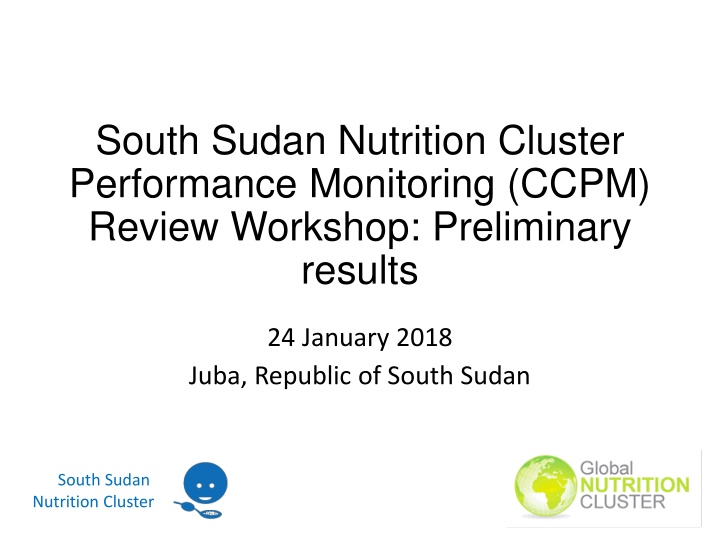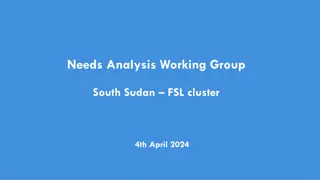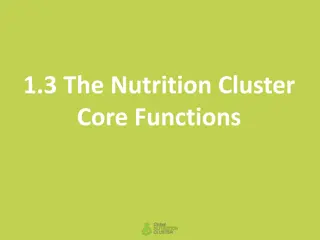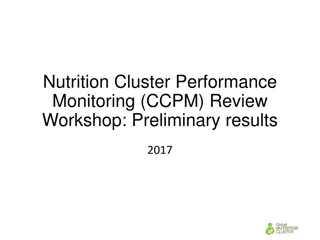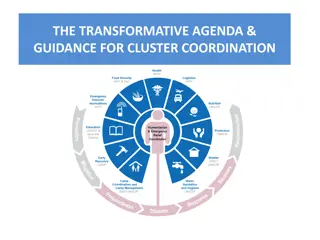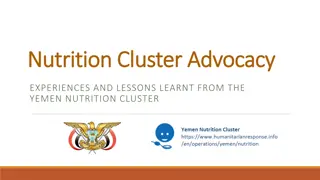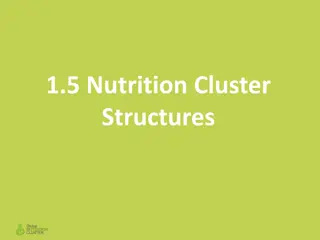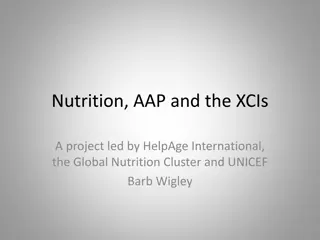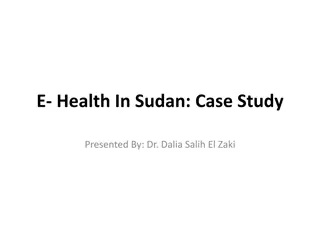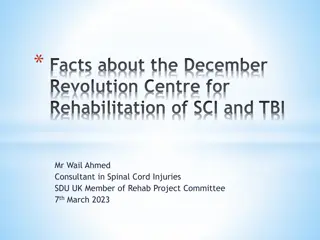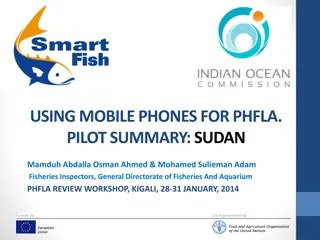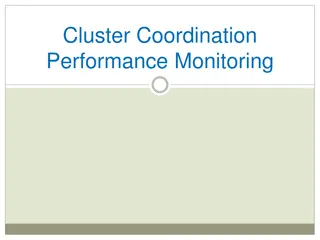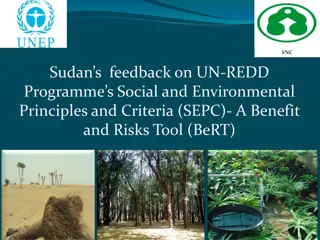Review of South Sudan Nutrition Cluster Performance Monitoring Workshop
Preliminary results from the South Sudan Nutrition Cluster Performance Monitoring (CCPM) Review Workshop held in Juba, Republic of South Sudan on 24th January 2018. The workshop aimed to ensure efficient coordination, identify areas for improvement, raise awareness of support needed, and strengthen transparency within the cluster. The CCPM process included planning, online survey, cluster analysis, action planning, and follow-up. Response rates and performance status were also discussed, emphasizing the importance of monitoring and evaluation in enhancing the cluster's effectiveness.
Download Presentation

Please find below an Image/Link to download the presentation.
The content on the website is provided AS IS for your information and personal use only. It may not be sold, licensed, or shared on other websites without obtaining consent from the author.If you encounter any issues during the download, it is possible that the publisher has removed the file from their server.
You are allowed to download the files provided on this website for personal or commercial use, subject to the condition that they are used lawfully. All files are the property of their respective owners.
The content on the website is provided AS IS for your information and personal use only. It may not be sold, licensed, or shared on other websites without obtaining consent from the author.
E N D
Presentation Transcript
South Sudan Nutrition Cluster Performance Monitoring (CCPM) Review Workshop: Preliminary results 24 January 2018 Juba, Republic of South Sudan South Sudan Nutrition Cluster
Objectives of South Sudan Nutrition CCPM Objectives of South Sudan Nutrition CCPM First CCPM took place in 2014 Regular CCPM exercises in 2015 and 2016-17; Ensure efficient and effective coordination Take stock of what functional areas work well and what areas need improvement Raise awareness of support needed from the HC/HCT, cluster lead agencies, global clusters or cluster partners Opportunity for self-reflection Strengthening transparency and partnership within the cluster Show the added value and justify the costs of coordination
Remember that CCPM Remember that CCPM DOES NOT DOES NOT Monitor response (service delivery by partners) Evaluate individual partners or coordinators Evaluate if/when clusters should be deactivated, merged etc. (Review of the cluster architecture) Exclude usage of other tools with the same purpose
Process of South Sudan Nutrition CCPM Process of South Sudan Nutrition CCPM Step 1, Planning: November 2017 Step 2, On-line CCPM Survey: December 2017- January 2018. Preliminary report issued XX January 2018 and shared with all cluster partners Step 3, Cluster analysis and action planning: CCPM Workshop and development of the Action Plan to improve performance 24 January 2018 Step 4, Follow-up and Monitoring : Finalisation of the Action Plan, presentation to the HCT/Government, implementation of the Action Plan
South Sudan Nutrition CCPM 2017 South Sudan Nutrition CCPM 2017- -2018: Response Rates 2018: Response Rates Partner Type Number of responded partners 0 Total number of partners Response Rate (%) 5 0.0% Donors 20 28 71.4% International NGOs National Authority National NGOs 1 1 100.0% 11 17 64.7% 0 1 0.0% ICRC/IFRC 4 4 100.0% UN Organizations 36 56 64% Total
Scores and Scores and Colour Colour Coding Coding Score Performance Status > 75% Good 51-75% Satisfactory, needs minor improvement 26-50% Unsatisfactory, needs major improvement 25% Weak
1. Supporting Service Delivery 1. Supporting Service Delivery IASC core functions Indicative characteristics of functions Score S. Sudan Cluster 2015 Score S. Sudan Cluster 2016-2017 Score S. Sudan Cluster 2017-2018 1.1 Provide a platform to ensure that service delivery is driven by the agreed strategic priorities 1.2 Develop mechanisms to eliminate duplication of service delivery Established, relevant coordination mechanism recognizing national systems, subnational and co-lead aspects; stakeholders participating regularly and effectively; cluster coordinator active in inter-cluster and related meetings. Cluster partner engagement in dynamic mapping of presence and capacity (4W); information sharing across clusters in line with joint Strategic Objectives. Good Good Good Satisfactory Good Good
2 2. Informing strategic decision . Informing strategic decision- -making of the HC/HCT for the humanitarian response HC/HCT for the humanitarian response making of the IASC core functions Indicative characteristics of functions Score S. Sudan Cluster 2015 Score S. Sudan Cluster 2016-17 Score S. Sudan Cluster 2017-18 2.1 Preparing needs assessments and analysis of gaps (across and within Clusters, using information management tools as needed) to inform the setting of priorities 2.2 Identifying and finding solutions for (emerging) gaps, obstacles, duplication and cross- cutting issues. Use of assessment tools in accordance with agreed minimum standards, individual assessment/ survey results shared and/or carried out jointly as appropriate. Satisfactory Good Good Joint analysis for current and anticipated risks, needs, gaps and constraints; cross cutting issues addressed from outset. Joint analysis supporting response planning and Good Satisfactory Good 2.3 Formulating priorities on the basis of analysis Satisfactory Good Good
3. 3. Planning and strategy development Planning and strategy development IASC core functions Indicative characteristics of functions Score S. Sudan Cluster 2015 Satisfactory Score S. Sudan Cluster 2016-2017 Satisfactory Score S. Sudan Cluster 2017-18 Good 3.1 Developing sectoral plans, objectives and indicators that directly support realization of the overall response s strategic objectives Strategic plan based on identified priorities, shows synergies with other sectors against strategic objectives, addresses cross cutting issues, incorporates exit strategy discussion and is developed jointly with partners. Plan is updated regularly and guides response. Use of existing national standards and guidelines where possible. Standards and guidance are agreed to, adhered to and reported against. Funding requirements determined with partners, allocation under jointly agreed criteria and prioritization, status tracked and information shared. 3.2 Applying and adhering to common standards and guidelines Good Good Good 3.3 Clarifying funding requirements, helping to set priorities, and agreeing Cluster contributions to the HC s overall humanitarian funding proposals Satisfactory Good Good
4. 4. Monitoring and Evaluating Performance Monitoring and Evaluating Performance IASC core functions Indicative characteristics of functions Score S. Sudan Cluster 2015 Score S. Sudan Cluster 2016-2017 Score S. Sudan Cluster 2017-2018 4.1 Monitoring and reporting on activities and needs Formats for monitoring and reporting needs agreed upon and used by cluster partners Reports shared by partners on humanitarian needs are taken into account in cluster reports Formats for monitoring and reporting activities agreed upon and used by cluster partners Reports shared by partners on their activities are taken into account in cluster reports Good Good Good 4.2 Measuring progress against the Cluster strategy and agreed results Progress reports or bulletins report using agreed indicators for monitoring humanitarian response Good Good 4.3 Recommending corrective action where necessary Cluster bulletins and updates influence partners decisions Good Good Cluster has used information to recommend corrective action
5. 5. Building national capacity in contingency Building national capacity in contingency planning/preparedness. planning/preparedness. IASC core functions Indicative characteristics Score S. Sudan Cluster 2015 Satisfactory Score S. Sudan Cluster 2016-17 Good Score S. Sudan Cluster 2017-18 Satisfactory of functions 5.1 National contingency plans identified, updated and shared 5.2 Cluster roles and responsibilities defined and understood National contingency plans identified and shared Role of the Cluster and partners are clearly defined and understood in the Contingency Plan The Cluster has discussed how to strengthen response capacity in country Satisfactory Satisfactory 5.3 Early warning reports shared with partners Early warning reports shared with partners Satisfactory Good
6 6. Undertake robust advocacy . Undertake robust advocacy IASC core functions Indicative characteristics of Score S. Sudan Cluster 2015 Satisfactory Score S. Sudan Cluster 2016-17 Good Score S. Sudan Cluster 2017-18 Satisfactory functions 4.1 Identify advocacy concerns to contribute to HC and HCT messaging and action 4.2 Undertaking advocacy activities on behalf of cluster participants and the affected population Concerns for advocacy identified with partners, including gaps, access, resource needs. Common advocacy campaign agreed and delivered across partners. Weak Good Good
Accountability to affected population Accountability to affected population AAP Indicative characteristics of functions Score S. Sudan Cluster 2015 Satisfactory Score S. Sudan Cluster 2016-17 Good Score S. Sudan Cluster 2017-18 Good 7.1 Mechanisms to consult and involve affected people in decision-making agreed upon and used by partners 7.2 Mechanisms to receive, investigate and act upon complaints on the assistance received agreed upon and used by partners 7.3 Key issues relating to protection from sexual exploitation and abuse have been raised and discussed Good Good Satisfactory Good
Next Steps for the CCPM Next Steps for the CCPM 3. Cluster analysis and action planning In a day meeting, the cluster will discuss and finalise the Cluster Description Report and Coordination Performance Report, and develop an Action Plan. 4. Follow-up and Monitoring The Cluster will continually review the Final Coordination Performance Report and Action Plan. The Coordination Performance Report and Action Plan will be presented to the HCT and global cluster, to identify support requirements. The cluster will continue to monitor the implementation of its Action Plan at regular intervals. 5. Ideally, the cluster should report to the HCT on the progress every quarter.
Group Work Group Work The team will divide into four working groups to: 1. Contextualize the findings of the Preliminary Coordination Performance Report (narrative comment boxes). 2. Identify actions for improvements for each of the six cluster functions + AAP. 3. On the basis of these discussions, a Final Cluster Description Report and Final Coordination Performance Report will be produced. Groups: WG1 cluster functions 1 and 4 WG2 cluster functions 2 and 3 WG3 cluster functions 5 and 6 WG4 - AAP
Group work: each group should Group work: each group should Review the performance status of the function (color coded in green/yellow/orange/red, and the more detailed scoring of the various questions related to the function) Identify what worked well for that function Discuss possible constraints as well as support requirements for that function Identify other issues relevant to cluster performance that were not included in the survey Identify and prioritise any improvements for that function, add inputs from the plenary feedback Summarise in a Word document
Plenary discussion Plenary discussion Report back in plenary; Seek feedback and endorsement on the recommendations from each of the working groups for each of the functions Jointly agree on up to 3-5 priorities follow-up actions to improve performance of any weak core functions (prioritise recommendations, but at least address all functions that are below satisfactory performance). Identify who is following up on each recommended improvement action and by when. It is important to allocate responsibilities at the meeting. Identify opportunities, constraints and/or request support, if needed.
